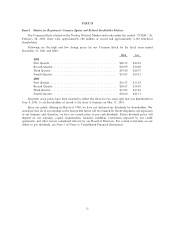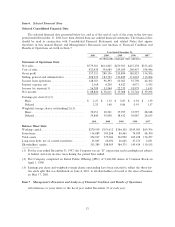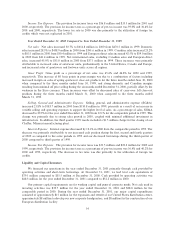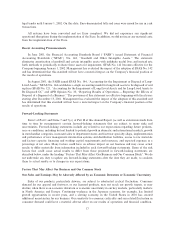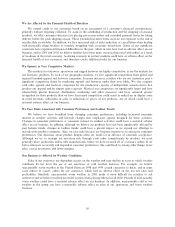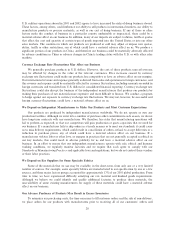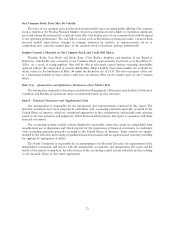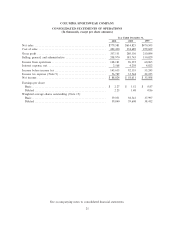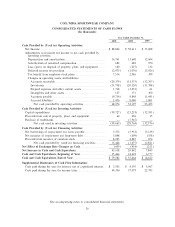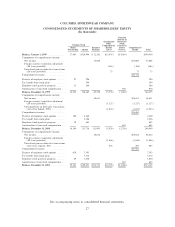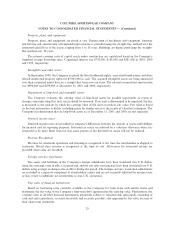Columbia Sportswear 2001 Annual Report Download - page 26
Download and view the complete annual report
Please find page 26 of the 2001 Columbia Sportswear annual report below. You can navigate through the pages in the report by either clicking on the pages listed below, or by using the keyword search tool below to find specific information within the annual report.U.S. military operations abroad in 2001 and 2002 appear to have increased the risks of doing business abroad.
These factors, among others, could inÖuence our ability to sell products in international markets, our ability to
manufacture products or procure materials, as well as our cost of doing business. If any of these or other
factors make the conduct of business in a particular country undesirable or impractical, there could be a
material adverse aÅect on our business. In addition, many of our imports are subject to duties, tariÅs or quotas
that aÅect the cost and quantity of certain types of goods imported into the United States or into our other
sales markets. The countries in which our products are produced or sold may adjust or impose new quotas,
duties, tariÅs or other restrictions, any of which could have a material adverse eÅect on us. We produce a
signiÑcant portion of our products in China, and therefore our business could be materially adversely aÅected
by adverse conditions in China or adverse changes in China's trading status with the U.S. or with other sales
markets.
Currency Exchange Rate Fluctuations May AÅect our Business
We generally purchase products in U.S. dollars. However, the cost of these products sourced overseas
may be aÅected by changes in the value of the relevant currencies. Price increases caused by currency
exchange rate Öuctuations could make our products less competitive or have an adverse aÅect on our margins.
Our international revenue and expense generally is derived from sales and operations in foreign currencies, and
this revenue and expense could be materially aÅected by currency Öuctuations, including amounts recorded in
foreign currencies and translated into U.S. dollars for consolidated Ñnancial reporting. Currency exchange rate
Öuctuations could also disrupt the business of the independent manufacturers that produce our products by
making their purchases of raw materials more expensive and more diÇcult to Ñnance. We conduct a program
to hedge against our exposure to currency exchange rate Öuctuations. We may not, however, be successful and
foreign currency Öuctuations could have a material adverse aÅect on us.
We Depend on Independent Manufacturers to Make Our Products and Meet Customer Expectations
Our products are produced by independent manufacturers worldwide. We do not operate or own any
production facilities. Although we enter into a number of purchase order commitments each season, we do not
have long-term contracts with any manufacturer. We therefore face risks that manufacturing operations will
fail to perform as expected, or that our competitors will gain production or quota capacities that we need for
our business. If a manufacturer fails to ship orders in a timely manner or to meet our standards, it could cause
us to miss delivery requirements, which could result in cancellation of orders, refusal to accept deliveries or a
reduction in purchase prices, any of which could have a material adverse aÅect on our business. If a
manufacturer violates labor or other laws, or engages in practices that are not generally accepted as ethical in
our key markets, this could result in adverse publicity for us and have a material adverse aÅect on our
business. In an eÅort to ensure that our independent manufacturers operate with safe, ethical and humane
working conditions, we regularly monitor factories and we require that each agree to comply with our
Standards of Manufacturing Practices and applicable laws and regulations, but we do not control these vendors
or their labor practices.
We Depend on Key Suppliers for Some Specialty Fabrics
Some of the materials that we use may be available, in the short-term, from only one or a very limited
number of sources. For example, some specialty fabrics are manufactured to our speciÑcation by one or a few
sources, and three major factory groups accounted for approximately 17% of our 2001 global production. From
time to time, we have experienced diÇculty satisfying our raw material and Ñnished goods requirements.
Although we believe we could identify and qualify additional factories to produce these materials, the
unavailability of some existing manufacturers for supply of these materials could have a material adverse
aÅect on our business.
Our Advance Purchases of Products May Result in Excess Inventories
To minimize our purchasing costs, the time necessary to Ñll customer orders and the risk of non-delivery,
we place orders for our products with manufacturers prior to receiving all of our customers' orders and
20



